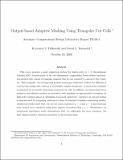Output-based Adaptive Meshing Using Triangular Cut Cells
Author(s)
Fidkowski, Krzysztof J.; Darmofal, David L.
DownloadACDL_TR-06-2.pdf (3.648Mb)
Metadata
Show full item recordAbstract
This report presents a mesh adaptation method for higher-order (p > 1) discontinuous Galerkin (DG) discretizations of the two-dimensional, compressible Navier-Stokes equations. The method uses a mesh of triangular elements that are not required to conform to the boundary. This triangular, cut-cell approach permits anisotropic adaptation without the difficulty of constructing meshes that conform to potentially complex geometries. A quadrature technique is presented for accurately integrating on general cut cells. In addition, an output-based error estimator and adaptive method are presented, with emphasis on appropriately accounting for high-order solution spaces in optimizing local mesh anisotropy. Accuracy on cut-cell meshes is demonstrated by comparing solutions to those on standard boundary-conforming meshes. Adaptation results show that, for all test cases considered, p = 2 and p = 3 discretizations meet desired error tolerances using fewer degrees of freedom than p = 1. Furthermore, an initial-mesh dependence study demonstrates that, for sufficiently low error tolerances, the final adapted mesh is relatively insensitive to the starting mesh.
Date issued
2006-10Publisher
Aerospace Computational Design Laboratory, Dept. of Aeronautics & Astronautics, Massachusetts Institute of Technology
Series/Report no.
ACDL Technical Reports;ACDL TR-06-2